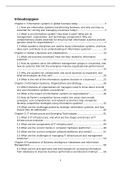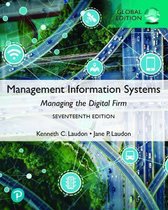Inhoudsopgave
Chapter 1: Information systems in global business today.....................................3
1.1 How are information systems transforming business, and why are they so
essential for running and managing a business today?......................................3
1.2 What is an information system? How does it work? What are its
management, organization, and technology components? Why are
complementary assets essential for ensuring that information systems provide
genuine value for organizations?........................................................................7
1.3 What academic disciplines are used to study information systems, and how
does each contribute to an understanding of information systems?................12
Chapter 2: Global e-business and collaboration...................................................14
2.1 What are business processes? How are they related to information
systems?........................................................................................................... 14
2.2 How do systems serve the different management groups in a business, and
how do systems that link the enterprise improve organizational performance?
......................................................................................................................... 15
2.3 Why are systems for collaboration and social business so important, and
what technologies do they use?.......................................................................20
2.4 What is the role of the information systems function in a business?..........25
Chapter 3 Information Systems, Organizations and Strategy..............................26
3.1 Which features of organizations do managers need to know about to build
and use information systems successfully?......................................................26
3.2 What is the impact of information systems on organizations?...................30
3.3 How do Porter’s competitive forces model, the value chain model,
synergies, core competencies, and network economics help companies
develop competitive strategies using information systems?............................32
3.4 What are the challenges posed by strategic information systems, and how
should they be addressed?...............................................................................40
Chapter 5: IT Infrastructure and Emerging Technologies.....................................41
5.1 What is IT infrastructure, and what are the stages and drivers of IT
infrastructure evolution.................................................................................... 41
5.2 What are the components of IT infrastructure?..........................................44
5.3 What are the current trends in computer hardware platforms?..................48
5.4 What are the current computer software platforms and trends?................51
5.5 What are the challenges of managing IT infrastructure and management
solutions?.......................................................................................................... 53
Chapter 6 Foundations of Business Intelligence: Databases and Information
Management........................................................................................................ 56
6.3 What are the principal tools and technologies for accessing information
from databases to improve business performance and decision making?........56
1
,Chapter 8 Securing Information Systems...........................................................59
8.1 Why are information systems vulnerable to destruction, error and abuse?59
8.2 What is the business value of security and control?...................................63
8.3 What are the components of an organizational framework for security and
control?............................................................................................................. 64
8.4 What are the most important tools and technologies for safeguarding
information resources?..................................................................................... 66
Chapter 9: Achieving operational excellence and customer intimacy: enterprise
applications......................................................................................................... 69
9.1 How do enterprise systems help businesses achieve operational
excellence?....................................................................................................... 69
9.2 How do supply chain management systems coordinate planning,
production and logistics with suppliers?...........................................................70
9.3 How do customer relationship management systems help firms achieve
customer intimacy?.......................................................................................... 74
9.4 What are the challenges that enterprise applications pose, and how are
enterprise applications taking advantage of new technologies?......................76
Chapter 11 Managing knowledge and artificial intelligence.................................77
11.1 What is the role of knowledge management systems in business?..........77
11.2 What are artificial intelligence (AI) and machine learning? How do
businesses use AI?............................................................................................ 79
11.3 What types of systems are used for enterprise-wide knowledge
management, and how do they provide value for businesses?........................84
11.4 What are the major types of knowledge work systems and how do they
provide value for firms?.................................................................................... 85
Chapter 13 Building information systems............................................................86
13.1 How does building new systems produce organizational change?...........86
13.2 What are the core activities in the systems development process?.........88
13.3 What are the principal methodologies for modelling and designing
systems?........................................................................................................... 91
13.4 What are alternative methods for building information systems?............92
13.5 What are new approaches for system building in the digital firm era?.....94
2
, Chapter 1: Information systems in global business
today
1.1 How are information systems transforming business, and why
are they so essential for running and managing a business today?
Information systems and technologies are transforming the global business
environment. In 2019 global spending on information technology (IT) and IT
services was nearly $3.8 trillion.
As managers you will work for firms that are intensively using information
systems and making large investments in information technology. You will want
to know how to invest this money wisely. If you make wise choices, your firm van
outperform competitors. If you make poor choices, you will be wasting valuable
capital.
1.1.1 What’s new in management information systems?
There is a whole new world of doing business using new technologies for
managing and organizing. What makes the MIS field the most exciting area of
study in schools of business is the continuous change in technology,
management, and business processes. Five changes are of paramount
importance:
1. IT Innovations. A continuing stream of information technology
innovations is transforming the traditional business world. Examples
include the emergence of cloud computing, the growth of a mobile digital
business platform based on smartphones and tablet computers, big data
and the Internet of Things (IoT), business analytics, machine learning
systems, and the use of social networks by managers to achieve business
objectives. These innovations are enabling entrepreneurs and innovative
traditional firms to create new products and services, develop new
business models, and transform the day-to-day conduct of business.
2. New Business Models. For instance, the emergence of online video
services for streaming or downloading, such as Netflix, has forever
changed how premium video is distributed and even created. Netflix is
challenging cable and broadcast producers of TV shows, and potentially
disrupting cable network dominance of TV show production.
3. E-commerce Expansion. E-commerce is changing how firms design,
produce, and deliver their products and services. E-commerce has
reinvented itself again, disrupting the traditional marketing and
advertising industry and putting major media and content firms in
jeopardy. Media firms are the new face of e-commerce. While selling
physical products is still a very powerful vision of e-commerce, growing
alongside is the service model of e-commerce.
4. Management Changes. The management of business firms has
changed: with new mobile smartphones, high-speed wireless Wi-Fi
networks, and tablets, remote salespeople on the road are only second
away from their managers’ questions and oversight. Management is going
mobile. The growth of enterprise wide information systems with
extraordinarily rich data means that managers no longer operate in a fog
3
, of confusion but instead have online, nearly instant access to really
important information they need for accurate and timely decisions.
5. Changes in Firms and Organisations. Compared to industrial
organizations of the precious century, new fast-growing twenty-first-
century business firms put less emphasis on hierarchy and structure and
more emphasis on employees taking on multiple roles and tasks and
collaborating with others on a team. They put greater emphasis on
competency and skills rather than position in the hierarchy. They
emphasize higher-speed and more-accurate decision making based on
data and analysis.
1.1.2 Globalization challenges and opportunities: a flattened world
The Internet has greatly heightened the competitive tensions among nations as
global trade expands and strengthened the benefits that flow from trade, and
also created significant dislocations in labour markets.
In 2005, journalist Thomas Friedman wrote an influential book declaring the
world was now flat, by which he meant that the Internet and global
communications had greatly expanded the opportunities for people to
communicate with one another and reduced the economic and cultural
advantages of developed countries.
A growing percentage of the economy of the United States and other advanced
industrial countries in Europe and Asia depends on imports and exports.
Its not just goods that move across borders. So too do jobs, some of them high-
level jobs that pay well and require a college degree.
Employment in information systems and the other service occupations listed
previously has rapidly expanded in sheer numbers, wages, productivity, and
quality of work. Outsourcing has actually accelerated the development of new
systems in the United States and worldwide by reducing the cost of building and
maintaining them.
What does globalization have to do with management information systems?
Everything. The emergence of the Internet into a full-blown international
communications system has drastically reduced the costs of operating and
transacting on the global scale.
1.1.3 The emerging digital firm
A digital firm is one in which nearly all of the organization’s significant business
relationships with customer, suppliers, and employees are digitally enabled and
mediated. Core business processes are accomplished through digital networks
spanning the entire organization or linking multiple organizations.
Business processes refer to the set of logically related tasks and behaviours
that organizations develop over time to produce specific business results and the
unique manner in which these activities are organized and coordinated.
Example: developing a new product & generating and fulfilling an order. The
ways organizations accomplish their business processes can be a source of
competitive strength.
4






